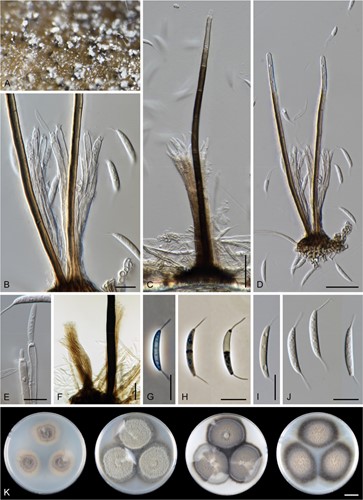Arcuatospora novae-zelandiae (S. Hughes & W.B. Kendr.) Réblová & Hern.-Restr.
MycoBank number: MB 839475; Index Fungorum number: IF 839475; Facesoffungi number: FoF14544
Basionym – Menisporopsis novae-zelandiae S. Hughes & W.B. Kendr., N. Z. J. Bot. 6: 369. 1968.
Characteristics in culture – On CMD colonies 24–28 mm diameter, circular, flat, margin entire, velvety-lanose, zonate, beige-grey, brown towards the margin with a beige outer zone, reverse dark brown. On MLA colonies 55–58 mm diameter, circular, raised, margin entire, lanose, floccose, funiculose, finely furrowed, olivaceous brown, dark olivaceous grey at the margin, diffusing dark amber pigment in the agar, reverse dark olivaceous brown. On OA colonies 60–62 mm diameter, circular, flat, margin entire, lanose, floccose centrally, mucoid to cobwebby towards the margin, dark olivaceous grey with irregular grey spots, reverse of the same colour. On PCA colonies 63–64 mm diameter, circular, slightly convex with a flat margin, margin entire to weakly fimbriate, lanose, floccose, funiculose centrally, mucoid to cobwebby towards the periphery, olivaceous brown, dark olivaceous grey at the margin, diffusing pale ochre pigment in the agar from the colony margin, reverse dark olivaceous brown. Sporulation was moderate on OA, absent on CMD, MLA and PCA.
Colonies on CMA with U. dioica stems effuse, hairy, mycelium composed of branched, septate, brown hyphae 1.5–3.5 µm diam. Anamorph: Setae 243–400 × 7.5–10.5 µm, 4–6.5 µm wide above the base, cylindrical or slightly widening from the base towards the middle, then gradually tapering towards the apex, solitary, erect, straight, dark brown to black, opaque, thick-walled, pale brown to subhyaline and thinner-walled at the apex, apex sterile, broadly rounded. Conidiophores 62–136 × 1.5–2.5 µm, macronematous, synnematous, closely bound, parallel, unbranched, erect, straight, arise in a group of 6–20 in separate bundles or surround the seta, diverge from it towards their apices and become unilateral, apically slightly bent when freed from the seta, pale brown, subhyaline at the apex, synnemata 7.5–14 µm wide near the base. Conidiogenous cells 12.5–25.5 × 3–3.5 µm, tapering to ca. 2(–2.5) µm below the collarette, integrated, terminal, monophialidic, occasionally extending percurrently, cylindrical-ovoid, pale brown, subhyaline towards the apex; collarettes 2.5–3.5 µm wide, ca. 1.5–2 µm deep, subhyaline, cup-shaped to funnel- shaped. Conidia 15.5–19.5 × 2–3 µm (mean ± SD = 17.8 ± 1.0 × 2.5 ± 0.4 µm), falcate, slightly truncate at the base with a basal scar, 1-septate, hyaline, with a straight or gently curved setula at each end 4.5–7.5 µm long, inserted terminally at the apex, subterminally at the base, conidia accumulate in slimy colourless fascicles. Teleomorph: not observed.
Specimens examined – VENEZUELA, Estado Miranda, in tropical cloud forest ‘Colonia Tovar’, on fallen decaying leaf of Nectandra sp., 25 November 2000, R.F. Castañeda-Ruíz & T. Itturiaga USB C00/77-3 (culture CBS 109474); Ibid., (culture CBS 109476).
Habitat and geographical distribution – Saprobe on decaying leaves and petioles, occasionally on fruits of a variety of hosts, including Beilschmiedia tarairi, Cinnamomum osmophloeum, C. zeylanicum, Cryptocarya mackinnoniana, Knightia excelsa, Nectandra sp., Ocotea leucoxylon, O. nemodaphne, Passania kawakamii, Quercus germana, Q. xalapensis, Quercus sp. and palms. It has been reported in Australia, Brazil, Costa Rica, Cuba, Ecuador, Mexico, New Zealand, Taiwan and Venezuela [6,9,63–70].
Note – For a description of the natural substrate, see Hughes and Kendrick [9]. The two specimens examined in this study originate from Venezuela [6]. The conidial size of A. novae-zelandiae recorded by several authors differs and reflects either significant intraspecific variability or interspecific differences. Our observations of conidia in culture (15.5–19.5 × 2–3 µm with setulae 4.5–7.5 µm long) correspond to the conidia from nature in the protologue (15–18 × 2.4–3.1 µm with setulae 4.3–5.7 µm long) [9]. Cruz et al. [70] reported specimens of A. novae-zelandiae on decaying leaves and petioles in Brazil with smaller conidia and shorter setulae (9.5–11 × 1–1.5 µm, setulae 3–5 µm long). Two of our Thailand strains (CBS 147509, CBS 147510), tentatively identified as A. novae-zelandiae, have longer conidia (18.5–23 × 2.5–3.5 µm) with longer setulae (6–10 µm) and correspond to the measurements given for this species by Matsushima [71].

Figure 2. Arcuatospora novae-zelandiae. (A) colony on CMA with Urtica stems (B) synnemata around the setae, in detail (C, D) Setae with unilateral synnemata (E) conidiogenous cells (F) synnemata growing with and without setae (G–J) conidia (K) colonies on CMD, MLA, OA and PCA after 4 weeks (from left to right). Images: (A–E,J) CBS 109476; (F–I,K) CBS 109475; (A–K) on CMA with Urtica stems after 4 weeks. Scale bars: (B,E,G–J) 10 µm; (C,D,F) 20 µm; (K) 1 cm.
